Menu Development: Planning and Design for Core Restaurant Report
VerifiedAdded on 2022/12/27
|9
|2854
|71
Report
AI Summary
This report provides a comprehensive analysis of menu development, planning, and design, focusing on the case of Core by Clare Smyth restaurant. It begins by defining menu development and outlining the principles of effective menu planning, including balance, customer needs, and variety. The report then compares and contrasts three menu types: static, cyclic, and Table d'Hote, evaluating their effectiveness in meeting both customer and business requirements. It explores how customer preferences and business needs impact menu design, considering factors like profit margin, staff expertise, medical requirements, and resource availability. The report offers recommendations for adapting to current trends, such as digital and QR code-based menus, and presents a detailed plan for a Table d'Hote menu, outlining design objectives, key considerations, and relevant key performance indicators (KPIs) to measure effectiveness. The analysis highlights the importance of aligning menu strategies with customer expectations and business goals for sustained success in the hospitality industry.
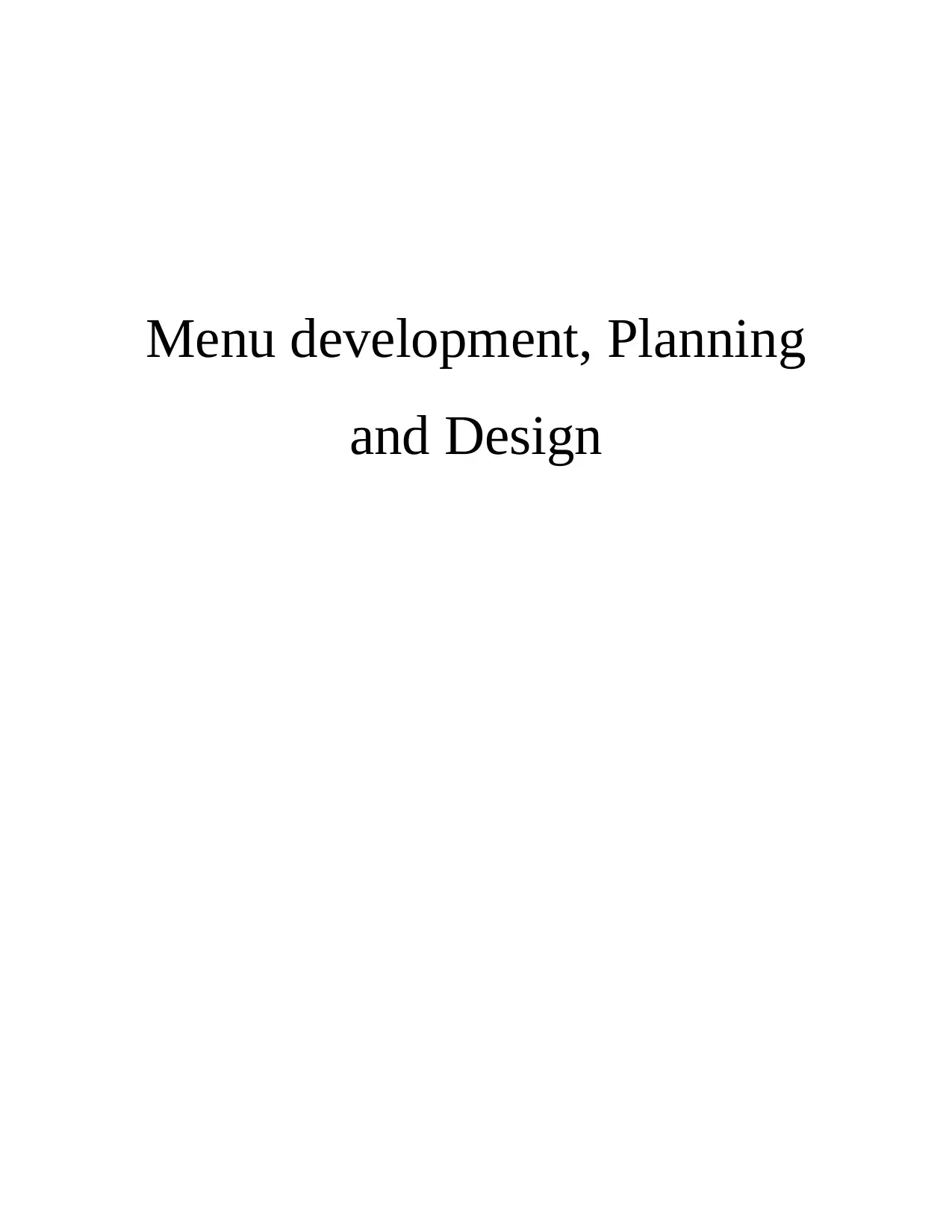
Menu development, Planning
and Design
and Design
Paraphrase This Document
Need a fresh take? Get an instant paraphrase of this document with our AI Paraphraser
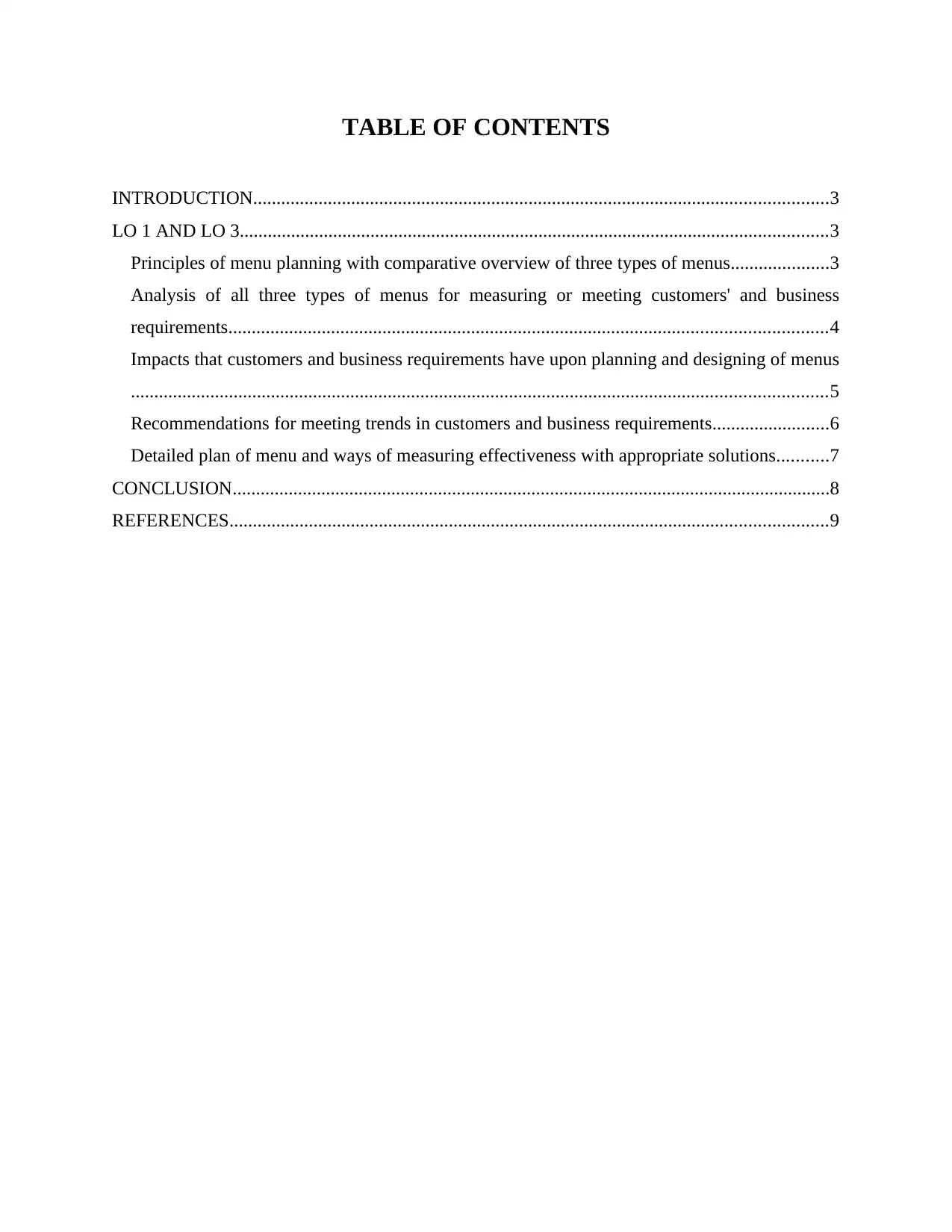
TABLE OF CONTENTS
INTRODUCTION...........................................................................................................................3
LO 1 AND LO 3..............................................................................................................................3
Principles of menu planning with comparative overview of three types of menus.....................3
Analysis of all three types of menus for measuring or meeting customers' and business
requirements................................................................................................................................4
Impacts that customers and business requirements have upon planning and designing of menus
.....................................................................................................................................................5
Recommendations for meeting trends in customers and business requirements.........................6
Detailed plan of menu and ways of measuring effectiveness with appropriate solutions...........7
CONCLUSION................................................................................................................................8
REFERENCES................................................................................................................................9
INTRODUCTION...........................................................................................................................3
LO 1 AND LO 3..............................................................................................................................3
Principles of menu planning with comparative overview of three types of menus.....................3
Analysis of all three types of menus for measuring or meeting customers' and business
requirements................................................................................................................................4
Impacts that customers and business requirements have upon planning and designing of menus
.....................................................................................................................................................5
Recommendations for meeting trends in customers and business requirements.........................6
Detailed plan of menu and ways of measuring effectiveness with appropriate solutions...........7
CONCLUSION................................................................................................................................8
REFERENCES................................................................................................................................9
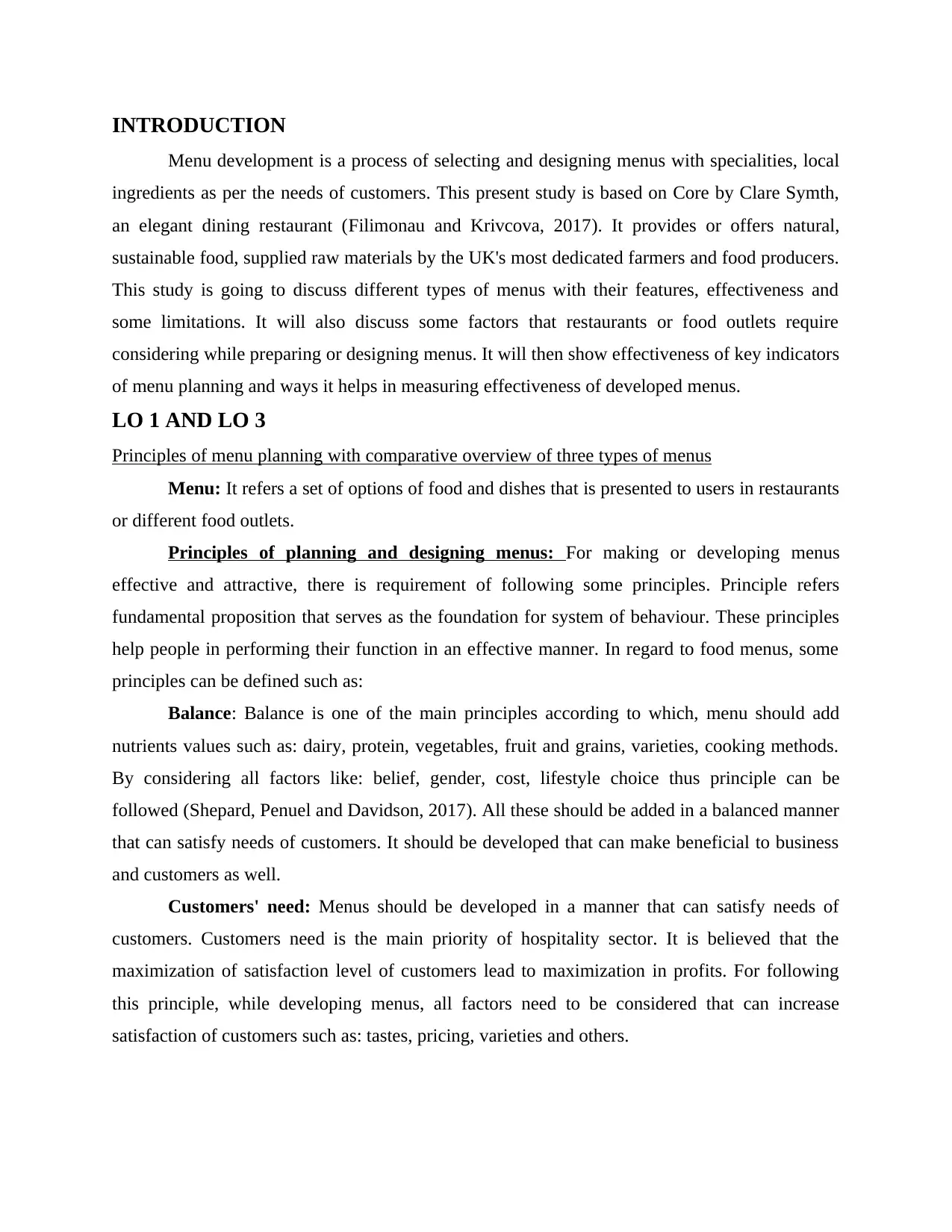
INTRODUCTION
Menu development is a process of selecting and designing menus with specialities, local
ingredients as per the needs of customers. This present study is based on Core by Clare Symth,
an elegant dining restaurant (Filimonau and Krivcova, 2017). It provides or offers natural,
sustainable food, supplied raw materials by the UK's most dedicated farmers and food producers.
This study is going to discuss different types of menus with their features, effectiveness and
some limitations. It will also discuss some factors that restaurants or food outlets require
considering while preparing or designing menus. It will then show effectiveness of key indicators
of menu planning and ways it helps in measuring effectiveness of developed menus.
LO 1 AND LO 3
Principles of menu planning with comparative overview of three types of menus
Menu: It refers a set of options of food and dishes that is presented to users in restaurants
or different food outlets.
Principles of planning and designing menus: For making or developing menus
effective and attractive, there is requirement of following some principles. Principle refers
fundamental proposition that serves as the foundation for system of behaviour. These principles
help people in performing their function in an effective manner. In regard to food menus, some
principles can be defined such as:
Balance: Balance is one of the main principles according to which, menu should add
nutrients values such as: dairy, protein, vegetables, fruit and grains, varieties, cooking methods.
By considering all factors like: belief, gender, cost, lifestyle choice thus principle can be
followed (Shepard, Penuel and Davidson, 2017). All these should be added in a balanced manner
that can satisfy needs of customers. It should be developed that can make beneficial to business
and customers as well.
Customers' need: Menus should be developed in a manner that can satisfy needs of
customers. Customers need is the main priority of hospitality sector. It is believed that the
maximization of satisfaction level of customers lead to maximization in profits. For following
this principle, while developing menus, all factors need to be considered that can increase
satisfaction of customers such as: tastes, pricing, varieties and others.
Menu development is a process of selecting and designing menus with specialities, local
ingredients as per the needs of customers. This present study is based on Core by Clare Symth,
an elegant dining restaurant (Filimonau and Krivcova, 2017). It provides or offers natural,
sustainable food, supplied raw materials by the UK's most dedicated farmers and food producers.
This study is going to discuss different types of menus with their features, effectiveness and
some limitations. It will also discuss some factors that restaurants or food outlets require
considering while preparing or designing menus. It will then show effectiveness of key indicators
of menu planning and ways it helps in measuring effectiveness of developed menus.
LO 1 AND LO 3
Principles of menu planning with comparative overview of three types of menus
Menu: It refers a set of options of food and dishes that is presented to users in restaurants
or different food outlets.
Principles of planning and designing menus: For making or developing menus
effective and attractive, there is requirement of following some principles. Principle refers
fundamental proposition that serves as the foundation for system of behaviour. These principles
help people in performing their function in an effective manner. In regard to food menus, some
principles can be defined such as:
Balance: Balance is one of the main principles according to which, menu should add
nutrients values such as: dairy, protein, vegetables, fruit and grains, varieties, cooking methods.
By considering all factors like: belief, gender, cost, lifestyle choice thus principle can be
followed (Shepard, Penuel and Davidson, 2017). All these should be added in a balanced manner
that can satisfy needs of customers. It should be developed that can make beneficial to business
and customers as well.
Customers' need: Menus should be developed in a manner that can satisfy needs of
customers. Customers need is the main priority of hospitality sector. It is believed that the
maximization of satisfaction level of customers lead to maximization in profits. For following
this principle, while developing menus, all factors need to be considered that can increase
satisfaction of customers such as: tastes, pricing, varieties and others.
⊘ This is a preview!⊘
Do you want full access?
Subscribe today to unlock all pages.

Trusted by 1+ million students worldwide
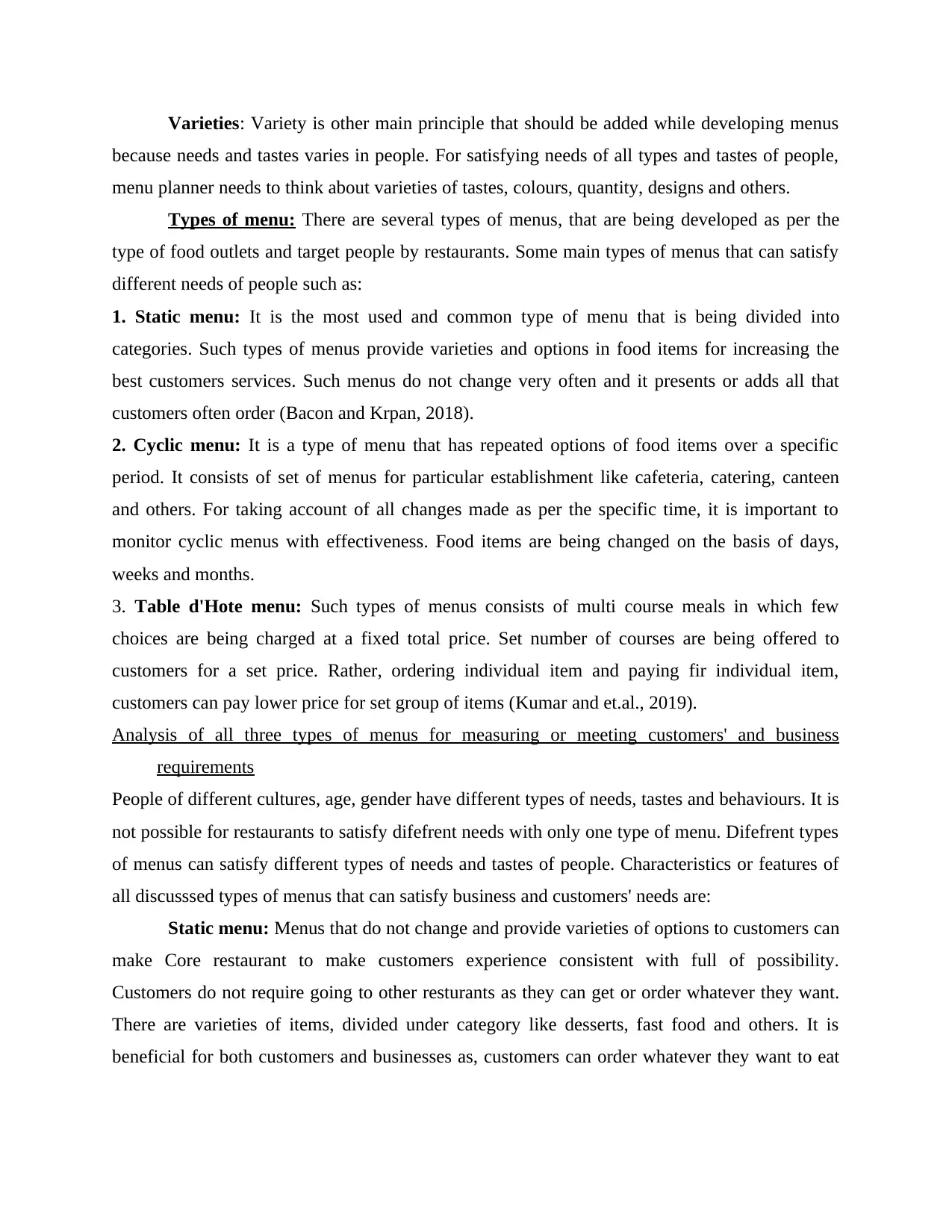
Varieties: Variety is other main principle that should be added while developing menus
because needs and tastes varies in people. For satisfying needs of all types and tastes of people,
menu planner needs to think about varieties of tastes, colours, quantity, designs and others.
Types of menu: There are several types of menus, that are being developed as per the
type of food outlets and target people by restaurants. Some main types of menus that can satisfy
different needs of people such as:
1. Static menu: It is the most used and common type of menu that is being divided into
categories. Such types of menus provide varieties and options in food items for increasing the
best customers services. Such menus do not change very often and it presents or adds all that
customers often order (Bacon and Krpan, 2018).
2. Cyclic menu: It is a type of menu that has repeated options of food items over a specific
period. It consists of set of menus for particular establishment like cafeteria, catering, canteen
and others. For taking account of all changes made as per the specific time, it is important to
monitor cyclic menus with effectiveness. Food items are being changed on the basis of days,
weeks and months.
3. Table d'Hote menu: Such types of menus consists of multi course meals in which few
choices are being charged at a fixed total price. Set number of courses are being offered to
customers for a set price. Rather, ordering individual item and paying fir individual item,
customers can pay lower price for set group of items (Kumar and et.al., 2019).
Analysis of all three types of menus for measuring or meeting customers' and business
requirements
People of different cultures, age, gender have different types of needs, tastes and behaviours. It is
not possible for restaurants to satisfy difefrent needs with only one type of menu. Difefrent types
of menus can satisfy different types of needs and tastes of people. Characteristics or features of
all discusssed types of menus that can satisfy business and customers' needs are:
Static menu: Menus that do not change and provide varieties of options to customers can
make Core restaurant to make customers experience consistent with full of possibility.
Customers do not require going to other resturants as they can get or order whatever they want.
There are varieties of items, divided under category like desserts, fast food and others. It is
beneficial for both customers and businesses as, customers can order whatever they want to eat
because needs and tastes varies in people. For satisfying needs of all types and tastes of people,
menu planner needs to think about varieties of tastes, colours, quantity, designs and others.
Types of menu: There are several types of menus, that are being developed as per the
type of food outlets and target people by restaurants. Some main types of menus that can satisfy
different needs of people such as:
1. Static menu: It is the most used and common type of menu that is being divided into
categories. Such types of menus provide varieties and options in food items for increasing the
best customers services. Such menus do not change very often and it presents or adds all that
customers often order (Bacon and Krpan, 2018).
2. Cyclic menu: It is a type of menu that has repeated options of food items over a specific
period. It consists of set of menus for particular establishment like cafeteria, catering, canteen
and others. For taking account of all changes made as per the specific time, it is important to
monitor cyclic menus with effectiveness. Food items are being changed on the basis of days,
weeks and months.
3. Table d'Hote menu: Such types of menus consists of multi course meals in which few
choices are being charged at a fixed total price. Set number of courses are being offered to
customers for a set price. Rather, ordering individual item and paying fir individual item,
customers can pay lower price for set group of items (Kumar and et.al., 2019).
Analysis of all three types of menus for measuring or meeting customers' and business
requirements
People of different cultures, age, gender have different types of needs, tastes and behaviours. It is
not possible for restaurants to satisfy difefrent needs with only one type of menu. Difefrent types
of menus can satisfy different types of needs and tastes of people. Characteristics or features of
all discusssed types of menus that can satisfy business and customers' needs are:
Static menu: Menus that do not change and provide varieties of options to customers can
make Core restaurant to make customers experience consistent with full of possibility.
Customers do not require going to other resturants as they can get or order whatever they want.
There are varieties of items, divided under category like desserts, fast food and others. It is
beneficial for both customers and businesses as, customers can order whatever they want to eat
Paraphrase This Document
Need a fresh take? Get an instant paraphrase of this document with our AI Paraphraser
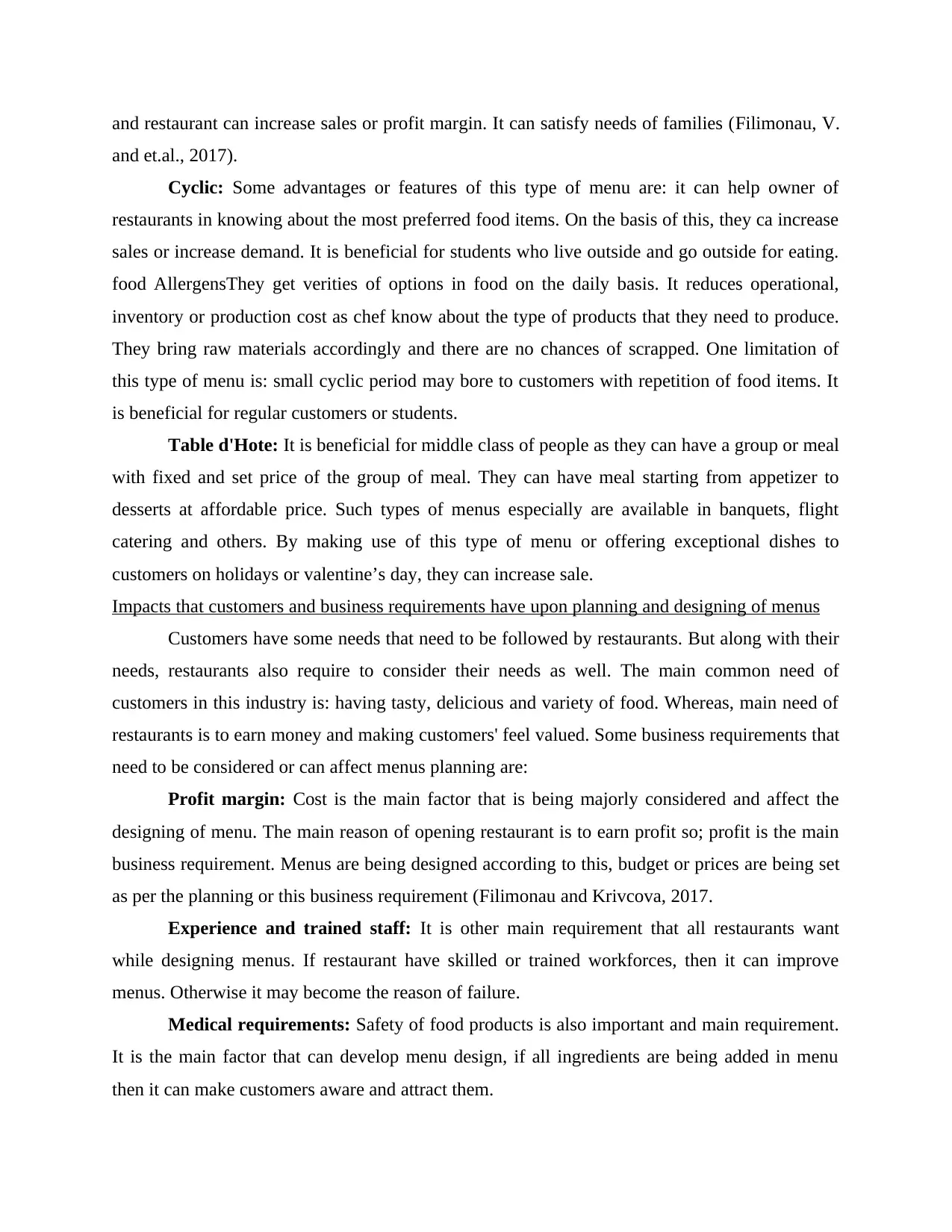
and restaurant can increase sales or profit margin. It can satisfy needs of families (Filimonau, V.
and et.al., 2017).
Cyclic: Some advantages or features of this type of menu are: it can help owner of
restaurants in knowing about the most preferred food items. On the basis of this, they ca increase
sales or increase demand. It is beneficial for students who live outside and go outside for eating.
food AllergensThey get verities of options in food on the daily basis. It reduces operational,
inventory or production cost as chef know about the type of products that they need to produce.
They bring raw materials accordingly and there are no chances of scrapped. One limitation of
this type of menu is: small cyclic period may bore to customers with repetition of food items. It
is beneficial for regular customers or students.
Table d'Hote: It is beneficial for middle class of people as they can have a group or meal
with fixed and set price of the group of meal. They can have meal starting from appetizer to
desserts at affordable price. Such types of menus especially are available in banquets, flight
catering and others. By making use of this type of menu or offering exceptional dishes to
customers on holidays or valentine’s day, they can increase sale.
Impacts that customers and business requirements have upon planning and designing of menus
Customers have some needs that need to be followed by restaurants. But along with their
needs, restaurants also require to consider their needs as well. The main common need of
customers in this industry is: having tasty, delicious and variety of food. Whereas, main need of
restaurants is to earn money and making customers' feel valued. Some business requirements that
need to be considered or can affect menus planning are:
Profit margin: Cost is the main factor that is being majorly considered and affect the
designing of menu. The main reason of opening restaurant is to earn profit so; profit is the main
business requirement. Menus are being designed according to this, budget or prices are being set
as per the planning or this business requirement (Filimonau and Krivcova, 2017.
Experience and trained staff: It is other main requirement that all restaurants want
while designing menus. If restaurant have skilled or trained workforces, then it can improve
menus. Otherwise it may become the reason of failure.
Medical requirements: Safety of food products is also important and main requirement.
It is the main factor that can develop menu design, if all ingredients are being added in menu
then it can make customers aware and attract them.
and et.al., 2017).
Cyclic: Some advantages or features of this type of menu are: it can help owner of
restaurants in knowing about the most preferred food items. On the basis of this, they ca increase
sales or increase demand. It is beneficial for students who live outside and go outside for eating.
food AllergensThey get verities of options in food on the daily basis. It reduces operational,
inventory or production cost as chef know about the type of products that they need to produce.
They bring raw materials accordingly and there are no chances of scrapped. One limitation of
this type of menu is: small cyclic period may bore to customers with repetition of food items. It
is beneficial for regular customers or students.
Table d'Hote: It is beneficial for middle class of people as they can have a group or meal
with fixed and set price of the group of meal. They can have meal starting from appetizer to
desserts at affordable price. Such types of menus especially are available in banquets, flight
catering and others. By making use of this type of menu or offering exceptional dishes to
customers on holidays or valentine’s day, they can increase sale.
Impacts that customers and business requirements have upon planning and designing of menus
Customers have some needs that need to be followed by restaurants. But along with their
needs, restaurants also require to consider their needs as well. The main common need of
customers in this industry is: having tasty, delicious and variety of food. Whereas, main need of
restaurants is to earn money and making customers' feel valued. Some business requirements that
need to be considered or can affect menus planning are:
Profit margin: Cost is the main factor that is being majorly considered and affect the
designing of menu. The main reason of opening restaurant is to earn profit so; profit is the main
business requirement. Menus are being designed according to this, budget or prices are being set
as per the planning or this business requirement (Filimonau and Krivcova, 2017.
Experience and trained staff: It is other main requirement that all restaurants want
while designing menus. If restaurant have skilled or trained workforces, then it can improve
menus. Otherwise it may become the reason of failure.
Medical requirements: Safety of food products is also important and main requirement.
It is the main factor that can develop menu design, if all ingredients are being added in menu
then it can make customers aware and attract them.
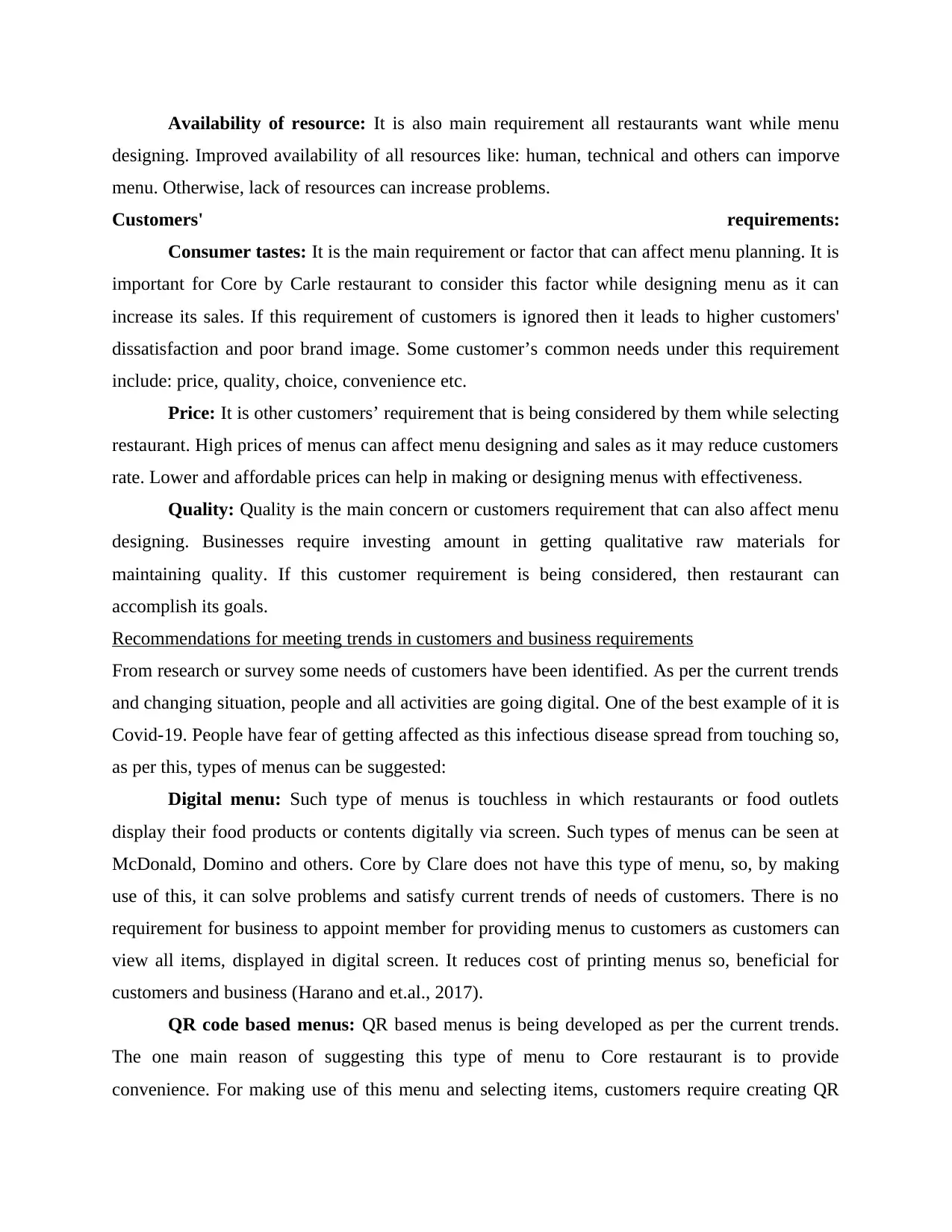
Availability of resource: It is also main requirement all restaurants want while menu
designing. Improved availability of all resources like: human, technical and others can imporve
menu. Otherwise, lack of resources can increase problems.
Customers' requirements:
Consumer tastes: It is the main requirement or factor that can affect menu planning. It is
important for Core by Carle restaurant to consider this factor while designing menu as it can
increase its sales. If this requirement of customers is ignored then it leads to higher customers'
dissatisfaction and poor brand image. Some customer’s common needs under this requirement
include: price, quality, choice, convenience etc.
Price: It is other customers’ requirement that is being considered by them while selecting
restaurant. High prices of menus can affect menu designing and sales as it may reduce customers
rate. Lower and affordable prices can help in making or designing menus with effectiveness.
Quality: Quality is the main concern or customers requirement that can also affect menu
designing. Businesses require investing amount in getting qualitative raw materials for
maintaining quality. If this customer requirement is being considered, then restaurant can
accomplish its goals.
Recommendations for meeting trends in customers and business requirements
From research or survey some needs of customers have been identified. As per the current trends
and changing situation, people and all activities are going digital. One of the best example of it is
Covid-19. People have fear of getting affected as this infectious disease spread from touching so,
as per this, types of menus can be suggested:
Digital menu: Such type of menus is touchless in which restaurants or food outlets
display their food products or contents digitally via screen. Such types of menus can be seen at
McDonald, Domino and others. Core by Clare does not have this type of menu, so, by making
use of this, it can solve problems and satisfy current trends of needs of customers. There is no
requirement for business to appoint member for providing menus to customers as customers can
view all items, displayed in digital screen. It reduces cost of printing menus so, beneficial for
customers and business (Harano and et.al., 2017).
QR code based menus: QR based menus is being developed as per the current trends.
The one main reason of suggesting this type of menu to Core restaurant is to provide
convenience. For making use of this menu and selecting items, customers require creating QR
designing. Improved availability of all resources like: human, technical and others can imporve
menu. Otherwise, lack of resources can increase problems.
Customers' requirements:
Consumer tastes: It is the main requirement or factor that can affect menu planning. It is
important for Core by Carle restaurant to consider this factor while designing menu as it can
increase its sales. If this requirement of customers is ignored then it leads to higher customers'
dissatisfaction and poor brand image. Some customer’s common needs under this requirement
include: price, quality, choice, convenience etc.
Price: It is other customers’ requirement that is being considered by them while selecting
restaurant. High prices of menus can affect menu designing and sales as it may reduce customers
rate. Lower and affordable prices can help in making or designing menus with effectiveness.
Quality: Quality is the main concern or customers requirement that can also affect menu
designing. Businesses require investing amount in getting qualitative raw materials for
maintaining quality. If this customer requirement is being considered, then restaurant can
accomplish its goals.
Recommendations for meeting trends in customers and business requirements
From research or survey some needs of customers have been identified. As per the current trends
and changing situation, people and all activities are going digital. One of the best example of it is
Covid-19. People have fear of getting affected as this infectious disease spread from touching so,
as per this, types of menus can be suggested:
Digital menu: Such type of menus is touchless in which restaurants or food outlets
display their food products or contents digitally via screen. Such types of menus can be seen at
McDonald, Domino and others. Core by Clare does not have this type of menu, so, by making
use of this, it can solve problems and satisfy current trends of needs of customers. There is no
requirement for business to appoint member for providing menus to customers as customers can
view all items, displayed in digital screen. It reduces cost of printing menus so, beneficial for
customers and business (Harano and et.al., 2017).
QR code based menus: QR based menus is being developed as per the current trends.
The one main reason of suggesting this type of menu to Core restaurant is to provide
convenience. For making use of this menu and selecting items, customers require creating QR
⊘ This is a preview!⊘
Do you want full access?
Subscribe today to unlock all pages.

Trusted by 1+ million students worldwide
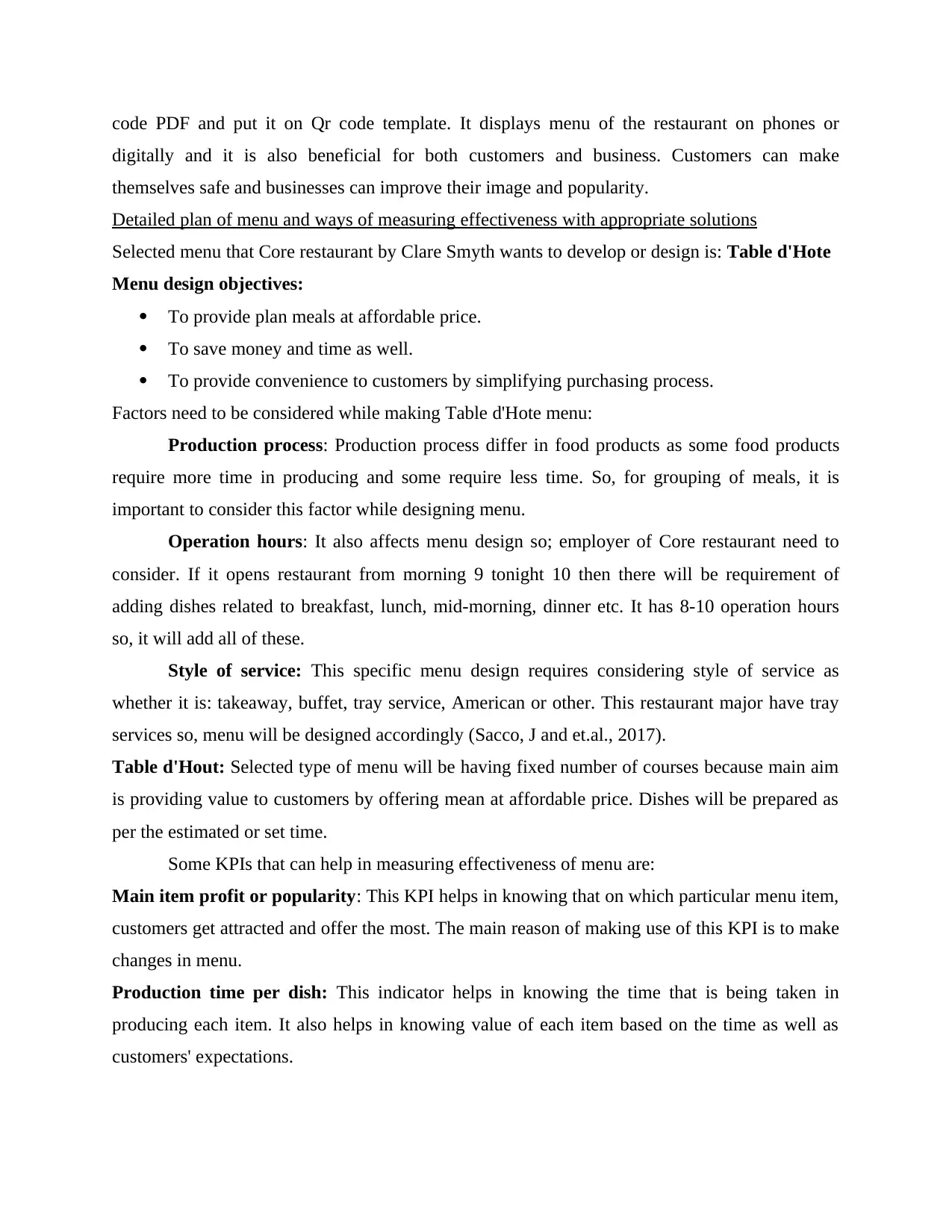
code PDF and put it on Qr code template. It displays menu of the restaurant on phones or
digitally and it is also beneficial for both customers and business. Customers can make
themselves safe and businesses can improve their image and popularity.
Detailed plan of menu and ways of measuring effectiveness with appropriate solutions
Selected menu that Core restaurant by Clare Smyth wants to develop or design is: Table d'Hote
Menu design objectives:
To provide plan meals at affordable price.
To save money and time as well.
To provide convenience to customers by simplifying purchasing process.
Factors need to be considered while making Table d'Hote menu:
Production process: Production process differ in food products as some food products
require more time in producing and some require less time. So, for grouping of meals, it is
important to consider this factor while designing menu.
Operation hours: It also affects menu design so; employer of Core restaurant need to
consider. If it opens restaurant from morning 9 tonight 10 then there will be requirement of
adding dishes related to breakfast, lunch, mid-morning, dinner etc. It has 8-10 operation hours
so, it will add all of these.
Style of service: This specific menu design requires considering style of service as
whether it is: takeaway, buffet, tray service, American or other. This restaurant major have tray
services so, menu will be designed accordingly (Sacco, J and et.al., 2017).
Table d'Hout: Selected type of menu will be having fixed number of courses because main aim
is providing value to customers by offering mean at affordable price. Dishes will be prepared as
per the estimated or set time.
Some KPIs that can help in measuring effectiveness of menu are:
Main item profit or popularity: This KPI helps in knowing that on which particular menu item,
customers get attracted and offer the most. The main reason of making use of this KPI is to make
changes in menu.
Production time per dish: This indicator helps in knowing the time that is being taken in
producing each item. It also helps in knowing value of each item based on the time as well as
customers' expectations.
digitally and it is also beneficial for both customers and business. Customers can make
themselves safe and businesses can improve their image and popularity.
Detailed plan of menu and ways of measuring effectiveness with appropriate solutions
Selected menu that Core restaurant by Clare Smyth wants to develop or design is: Table d'Hote
Menu design objectives:
To provide plan meals at affordable price.
To save money and time as well.
To provide convenience to customers by simplifying purchasing process.
Factors need to be considered while making Table d'Hote menu:
Production process: Production process differ in food products as some food products
require more time in producing and some require less time. So, for grouping of meals, it is
important to consider this factor while designing menu.
Operation hours: It also affects menu design so; employer of Core restaurant need to
consider. If it opens restaurant from morning 9 tonight 10 then there will be requirement of
adding dishes related to breakfast, lunch, mid-morning, dinner etc. It has 8-10 operation hours
so, it will add all of these.
Style of service: This specific menu design requires considering style of service as
whether it is: takeaway, buffet, tray service, American or other. This restaurant major have tray
services so, menu will be designed accordingly (Sacco, J and et.al., 2017).
Table d'Hout: Selected type of menu will be having fixed number of courses because main aim
is providing value to customers by offering mean at affordable price. Dishes will be prepared as
per the estimated or set time.
Some KPIs that can help in measuring effectiveness of menu are:
Main item profit or popularity: This KPI helps in knowing that on which particular menu item,
customers get attracted and offer the most. The main reason of making use of this KPI is to make
changes in menu.
Production time per dish: This indicator helps in knowing the time that is being taken in
producing each item. It also helps in knowing value of each item based on the time as well as
customers' expectations.
Paraphrase This Document
Need a fresh take? Get an instant paraphrase of this document with our AI Paraphraser
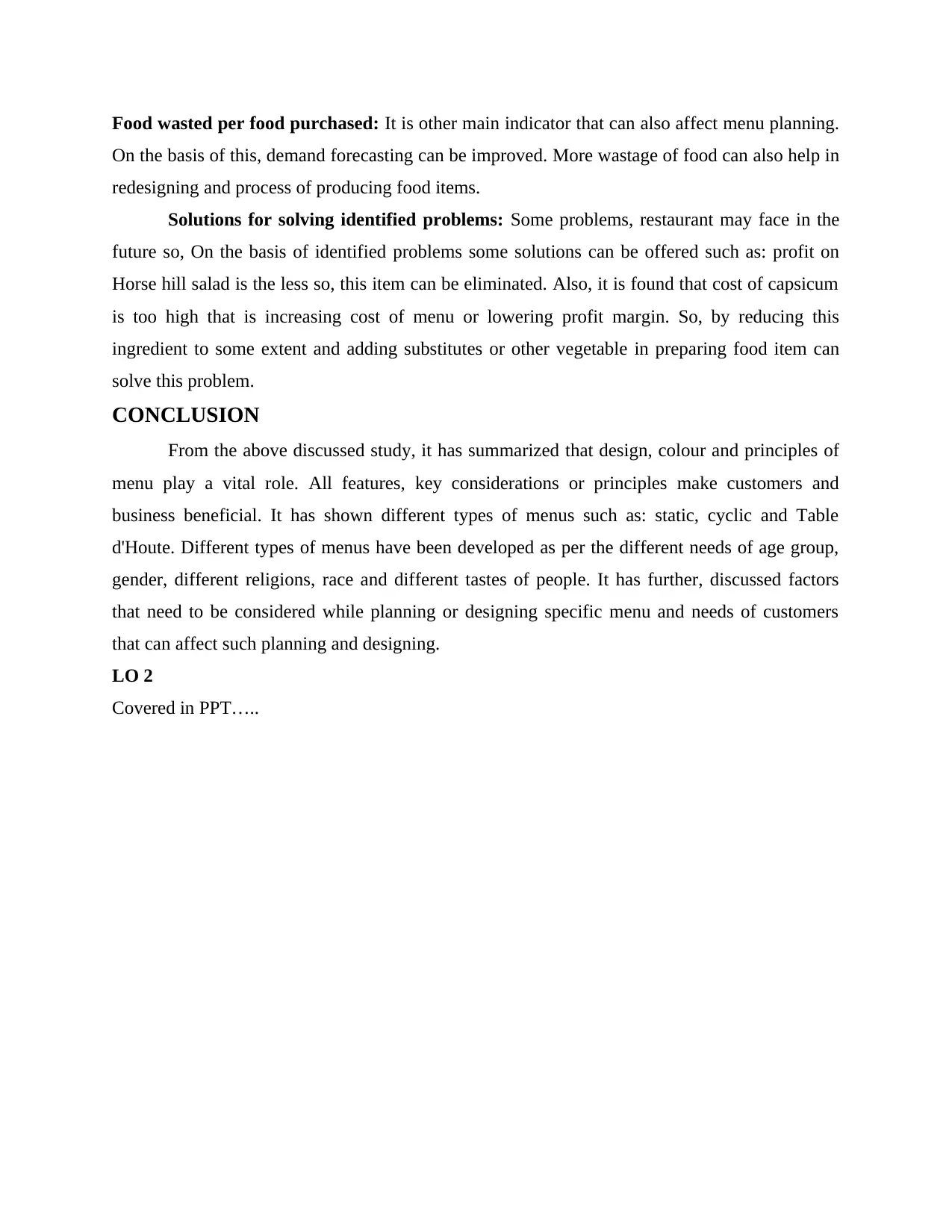
Food wasted per food purchased: It is other main indicator that can also affect menu planning.
On the basis of this, demand forecasting can be improved. More wastage of food can also help in
redesigning and process of producing food items.
Solutions for solving identified problems: Some problems, restaurant may face in the
future so, On the basis of identified problems some solutions can be offered such as: profit on
Horse hill salad is the less so, this item can be eliminated. Also, it is found that cost of capsicum
is too high that is increasing cost of menu or lowering profit margin. So, by reducing this
ingredient to some extent and adding substitutes or other vegetable in preparing food item can
solve this problem.
CONCLUSION
From the above discussed study, it has summarized that design, colour and principles of
menu play a vital role. All features, key considerations or principles make customers and
business beneficial. It has shown different types of menus such as: static, cyclic and Table
d'Houte. Different types of menus have been developed as per the different needs of age group,
gender, different religions, race and different tastes of people. It has further, discussed factors
that need to be considered while planning or designing specific menu and needs of customers
that can affect such planning and designing.
LO 2
Covered in PPT…..
On the basis of this, demand forecasting can be improved. More wastage of food can also help in
redesigning and process of producing food items.
Solutions for solving identified problems: Some problems, restaurant may face in the
future so, On the basis of identified problems some solutions can be offered such as: profit on
Horse hill salad is the less so, this item can be eliminated. Also, it is found that cost of capsicum
is too high that is increasing cost of menu or lowering profit margin. So, by reducing this
ingredient to some extent and adding substitutes or other vegetable in preparing food item can
solve this problem.
CONCLUSION
From the above discussed study, it has summarized that design, colour and principles of
menu play a vital role. All features, key considerations or principles make customers and
business beneficial. It has shown different types of menus such as: static, cyclic and Table
d'Houte. Different types of menus have been developed as per the different needs of age group,
gender, different religions, race and different tastes of people. It has further, discussed factors
that need to be considered while planning or designing specific menu and needs of customers
that can affect such planning and designing.
LO 2
Covered in PPT…..
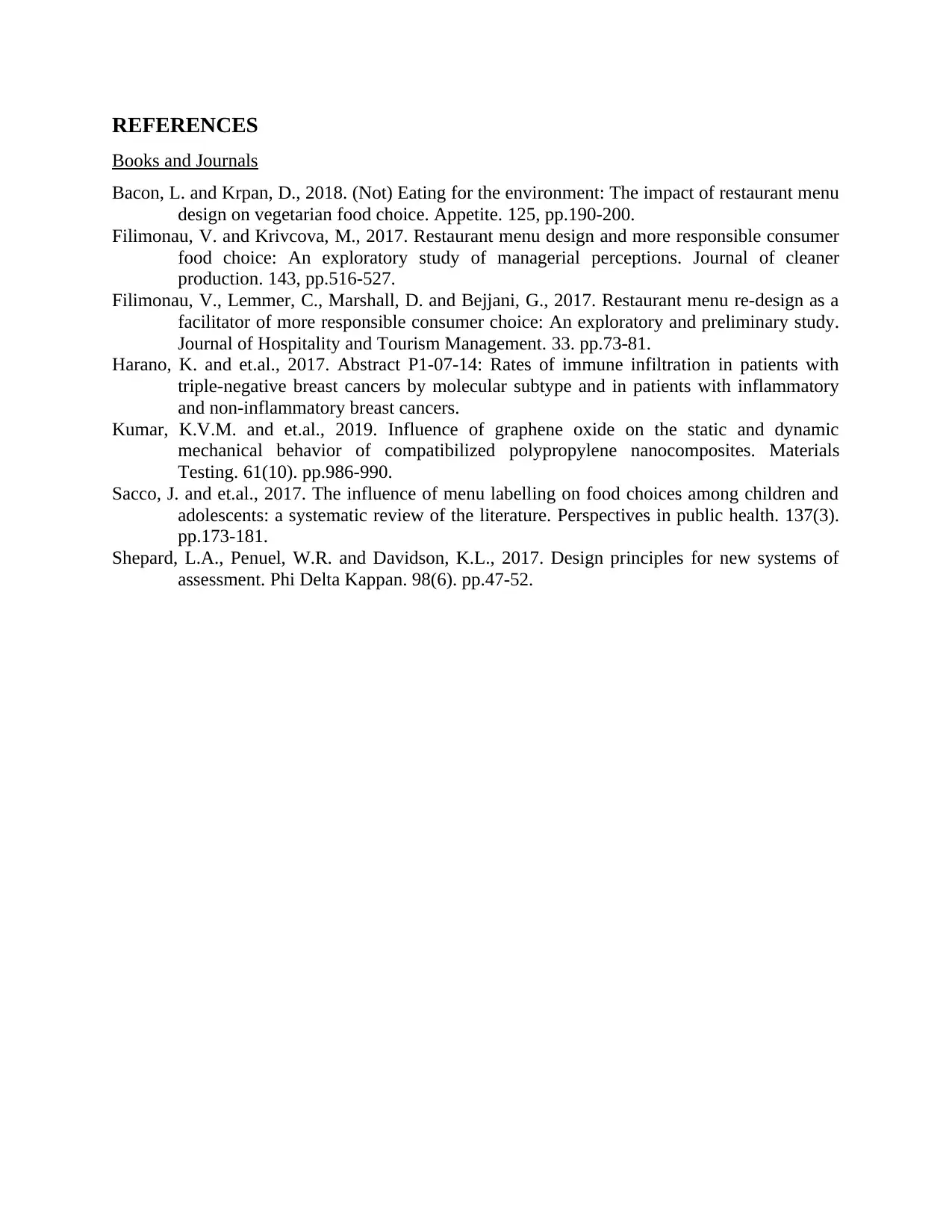
REFERENCES
Books and Journals
Bacon, L. and Krpan, D., 2018. (Not) Eating for the environment: The impact of restaurant menu
design on vegetarian food choice. Appetite. 125, pp.190-200.
Filimonau, V. and Krivcova, M., 2017. Restaurant menu design and more responsible consumer
food choice: An exploratory study of managerial perceptions. Journal of cleaner
production. 143, pp.516-527.
Filimonau, V., Lemmer, C., Marshall, D. and Bejjani, G., 2017. Restaurant menu re-design as a
facilitator of more responsible consumer choice: An exploratory and preliminary study.
Journal of Hospitality and Tourism Management. 33. pp.73-81.
Harano, K. and et.al., 2017. Abstract P1-07-14: Rates of immune infiltration in patients with
triple-negative breast cancers by molecular subtype and in patients with inflammatory
and non-inflammatory breast cancers.
Kumar, K.V.M. and et.al., 2019. Influence of graphene oxide on the static and dynamic
mechanical behavior of compatibilized polypropylene nanocomposites. Materials
Testing. 61(10). pp.986-990.
Sacco, J. and et.al., 2017. The influence of menu labelling on food choices among children and
adolescents: a systematic review of the literature. Perspectives in public health. 137(3).
pp.173-181.
Shepard, L.A., Penuel, W.R. and Davidson, K.L., 2017. Design principles for new systems of
assessment. Phi Delta Kappan. 98(6). pp.47-52.
Books and Journals
Bacon, L. and Krpan, D., 2018. (Not) Eating for the environment: The impact of restaurant menu
design on vegetarian food choice. Appetite. 125, pp.190-200.
Filimonau, V. and Krivcova, M., 2017. Restaurant menu design and more responsible consumer
food choice: An exploratory study of managerial perceptions. Journal of cleaner
production. 143, pp.516-527.
Filimonau, V., Lemmer, C., Marshall, D. and Bejjani, G., 2017. Restaurant menu re-design as a
facilitator of more responsible consumer choice: An exploratory and preliminary study.
Journal of Hospitality and Tourism Management. 33. pp.73-81.
Harano, K. and et.al., 2017. Abstract P1-07-14: Rates of immune infiltration in patients with
triple-negative breast cancers by molecular subtype and in patients with inflammatory
and non-inflammatory breast cancers.
Kumar, K.V.M. and et.al., 2019. Influence of graphene oxide on the static and dynamic
mechanical behavior of compatibilized polypropylene nanocomposites. Materials
Testing. 61(10). pp.986-990.
Sacco, J. and et.al., 2017. The influence of menu labelling on food choices among children and
adolescents: a systematic review of the literature. Perspectives in public health. 137(3).
pp.173-181.
Shepard, L.A., Penuel, W.R. and Davidson, K.L., 2017. Design principles for new systems of
assessment. Phi Delta Kappan. 98(6). pp.47-52.
⊘ This is a preview!⊘
Do you want full access?
Subscribe today to unlock all pages.

Trusted by 1+ million students worldwide
1 out of 9
Related Documents
Your All-in-One AI-Powered Toolkit for Academic Success.
+13062052269
info@desklib.com
Available 24*7 on WhatsApp / Email
![[object Object]](/_next/static/media/star-bottom.7253800d.svg)
Unlock your academic potential
Copyright © 2020–2025 A2Z Services. All Rights Reserved. Developed and managed by ZUCOL.



